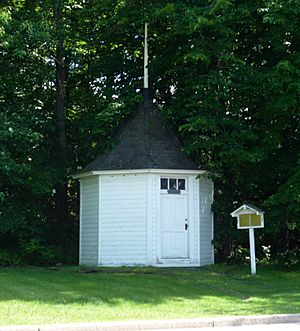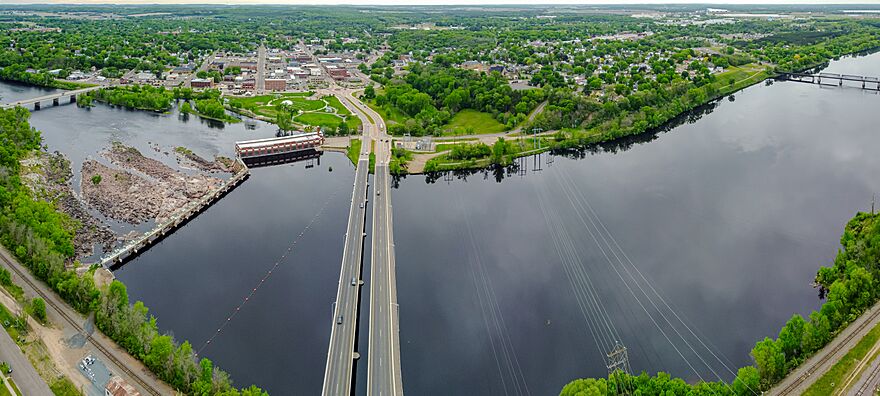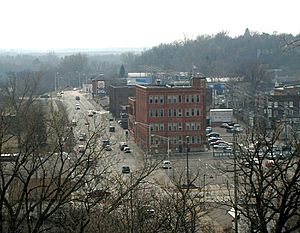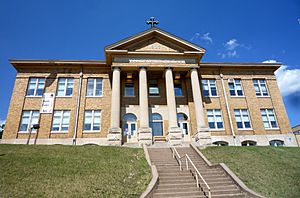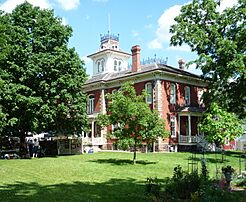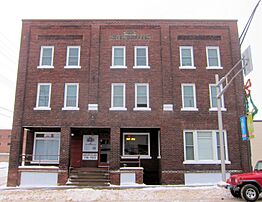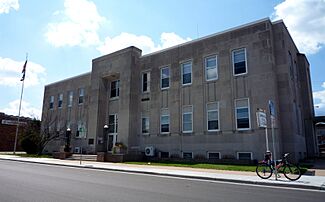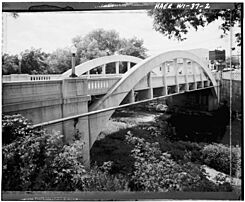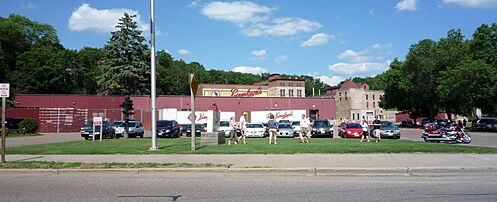Chippewa Falls, Wisconsin facts for kids
Quick facts for kids
Chippewa Falls, Wisconsin
|
||
|---|---|---|

Chippewa Falls Chamber Building Downtown
|
||
|
||

Location of Chippewa Falls in Chippewa County, Wisconsin.
|
||
| Country | ||
| State | ||
| County | Chippewa | |
| Area | ||
| • Total | 11.86 sq mi (30.72 km2) | |
| • Land | 11.32 sq mi (29.31 km2) | |
| • Water | 0.54 sq mi (1.41 km2) | |
| Elevation | 820 ft (250 m) | |
| Population
(2020 United States Census)
|
||
| • Total | 14,731 | |
| • Density | 1,301.7/sq mi (502.6/km2) | |
| Time zone | UTC-6 (Central (CST)) | |
| • Summer (DST) | UTC-5 (CDT) | |
| Zip code |
54729, 54774 (companies/organisations)
|
|
| Area code(s) | 715 & 534 | |
| FIPS code | 55-14575 | |
| GNIS feature ID | 1563041 | |
| Website | ci.chippewa-falls.wi.us | |
Chippewa Falls (![]() i/ˌtʃɪpəwə ˈfɔːlz/) is a city in Wisconsin, United States. It is located on the Chippewa River in Chippewa County, Wisconsin. In 2020, about 14,731 people lived there.
i/ˌtʃɪpəwə ˈfɔːlz/) is a city in Wisconsin, United States. It is located on the Chippewa River in Chippewa County, Wisconsin. In 2020, about 14,731 people lived there.
Chippewa Falls became a city in 1869. It is the main city, or county seat, of Chippewa County. The city gets its name from the Chippewa River, which was named after the Ojibwe people. It is also a major city in the Eau Claire–Chippewa Falls metropolitan area.
This city is famous for being the birthplace of Seymour Cray. He is known as the "father of supercomputing" because he helped create very powerful computers. Chippewa Falls is also home to the Jacob Leinenkugel Brewing Company. You can visit the Heyde Center for the Arts to see art and performances. Irvine Park is a great place to explore. The city also hosts the yearly Northern Wisconsin State Fair.
Contents
History of Chippewa Falls
For thousands of years, the Chippewa River was like a natural highway. Native American groups, including the Ojibwe people and Lakota, used it to travel through the forests and swamps. Later, Native Americans helped European explorers travel up the river and around the Falls.
Early European Exploration and Settlement
In 1700, Pierre LeSueur found the Chippewa Spring. At that time, this area was part of New France. Later, in 1768, Jonathan Carver explored the river when the area was claimed by Britain.
White settlers began to arrive in 1838. Lyman Warren and his wife, who was mostly Ojibwe, started a farm and a blacksmith shop. Their farm also served as a trading post for the American Fur Company.
The Rise of the Lumber Industry
The Chippewa River area had many valuable trees, especially white pine. Before railroads, the only way to move these logs was down the river. In 1837, a treaty opened this part of Wisconsin for logging. Jean Brunett led a team to build the first sawmill at the Falls. Even though it was hard work, they built the mill. A big storm destroyed most of it in 1846, but it was quickly rebuilt.
A small town grew around the sawmill. In 1854, Chippewa Falls became the main city for Chippewa County. By 1857, the town had a school, a post office, stores, churches, and a newspaper. In 1869, Chippewa Falls officially became a city with about 2,500 people. In the 1870s, the city added boardwalks, gas streetlights, and a telephone line.
Railroads and Growth
Railroads arrived in the 1870s, making it easier to travel and transport goods. In 1875, a railway connected Chippewa Falls to a larger line. More railroads were built in the 1880s, connecting the city to places like St. Paul, Minnesota, and Superior, Wisconsin.
The lumber business kept growing. By the 1880s, the Chippewa valley had some of the best white pine forests left. The sawmill in Chippewa Falls was very large. It was said to be "the largest sawmill under one roof in the world." The company employed 400 people.
The Chippewa Spring became well-known again in 1887. A politician named Thaddeus C. Pound started a health club there. He also helped a company that bottled the spring water to sell. The original Spring House was built in 1893. You can still see it today, across from the modern water bottling plant.
New Industries and Modern Times
Other businesses started in the 1880s and 1890s. These included flour mills, a brewery, and factories for shoes, cigars, and brooms. By 1902, people realized that the pine forests would not last forever. Business leaders worked to bring in new types of industries. They helped start more shoe factories, a sugar beet factory, and a glove factory.
The big sawmill closed in 1911. However, the new industries helped the city keep going. By 1920, Chippewa Falls had fifty factories that employed 3,000 workers.
Geography and Climate
Chippewa Falls is located on the north side of the Chippewa River. It is about three miles west of Lake Wissota.
The city covers a total area of about 11.86 square miles (30.7 km2). Most of this area, about 11.32 square miles (29.3 km2), is land. The rest, about 0.54 square miles (1.4 km2), is water.
What is the Climate Like?
The climate in Chippewa Falls has cold winters and warm summers.
|
||||||||||||||||||||||||||||||||||||||||||||||||||||||||||||||||||||||||||||||||||||||||||||||||
Population and People
Chippewa Falls has grown steadily over the years.
| Historical population | |||
|---|---|---|---|
| Census | Pop. | %± | |
| 1870 | 2,507 | — | |
| 1880 | 3,982 | 58.8% | |
| 1890 | 8,670 | 117.7% | |
| 1900 | 8,094 | −6.6% | |
| 1910 | 8,893 | 9.9% | |
| 1920 | 9,130 | 2.7% | |
| 1930 | 9,539 | 4.5% | |
| 1940 | 10,368 | 8.7% | |
| 1950 | 11,088 | 6.9% | |
| 1960 | 11,708 | 5.6% | |
| 1970 | 12,351 | 5.5% | |
| 1980 | 12,270 | −0.7% | |
| 1990 | 12,727 | 3.7% | |
| 2000 | 12,925 | 1.6% | |
| 2010 | 13,661 | 5.7% | |
| 2020 | 14,731 | 7.8% | |
| WI Counties 1900-1990 | |||
Population in 2020
According to the 2020 census, the population was 14,731. The city had about 1,301.7 people per square mile. Most of the people living in Chippewa Falls were White (90.1%). Other groups included Black or African American (1.9%), Asian (1.3%), and Native American (0.7%). About 2.5% of the population was Hispanic or Latino.
Economy and Jobs

In 2011, some of the biggest employers in Chippewa Falls included:
| 1 | TTM Advanced Circuits |
| 2 | Chippewa Falls Public Schools |
| 3 | Saint Joseph's Hospital |
| 4 | Wal-Mart |
| 5 | Mason Companies Inc |
| 6 | Chippewa County |
| 7 | Silicon Graphics International |
| 8 | Cooperative Educational Service Agency #10 |
| 9 | Cray Inc |
| 10 | Wissota Healthcare Regional Vent CT |
Transportation
Chippewa Falls is connected by several important roads. These include U.S. Highway 53, Wisconsin Highway 124, Wisconsin Highway 178, and Bus. WIS 29. Other routes like Wisconsin Highway 29 and various County Highways also serve the city.
Education in Chippewa Falls
The Chippewa Falls Area School District (CFSD) serves the city. It has two high schools, two middle schools, and six elementary schools.
There are also several private Catholic schools. These include McDonell Central Catholic High School, Notre Dame Middle School, and several elementary schools.
The old McDonell High School building is a historic place. It was built in 1907. After the high school moved, the building became the Heyde Center for the Arts in 2000. It is now a place for art and performances.
Famous People from Chippewa Falls
Many interesting people have come from Chippewa Falls.
Politicians
- Edward Ackley, a member of the Wisconsin State Senate.
- William B. Bartlett, a member of the Wisconsin State Assembly.
- Howard W. Cameron, a member of the Wisconsin State Senate.
- Wilder W. Crane, Jr., a member of the Wisconsin State Assembly.
- Gary Grant, a member of the Washington House of Representatives.
- Leo Richard Hamilton, a member of the Wisconsin State Assembly.
- Thomas S. Hogan, who was the Montana Secretary of State.
- John J. Jenkins, a U.S. Representative.
- Henry Laycock, a member of the Wisconsin State Assembly.
- Dick Leinenkugel, a businessman and politician. He served as the Wisconsin Secretary of Commerce.
- Hector McRae, a member of the Wisconsin State Assembly.
- Charles F. Morris, a member of the Wisconsin State Assembly.
- Terry Moulton, a member of the Wisconsin State Senate.
- Arthur L. Padrutt, a member of the Wisconsin State Senate.
- Bruce Peloquin, a member of the Wisconsin State Senate.
- Bradley Phillips, a member of the Wisconsin State Assembly.
- Thaddeus C. Pound, a U.S. Representative and grandfather of poet Ezra Pound.
- Ingolf E. Rasmus, a lawyer and member of the Wisconsin State Assembly.
- Paul H. Raihle, an author, lawyer, and member of the Wisconsin State Assembly.
- Sylvia H. Raihle, a homesteader and member of the Wisconsin State Assembly.
- Marvin J. Roshell, a member of the Wisconsin State Senate.
- Lycurgus J. Rusk, a member of the Wisconsin State Assembly.
- Chuck Schafer, a member of the Wisconsin State Assembly.
- Tom Sykora, elected to the Wisconsin State Assembly in 1994.
- John W. Thomas, a member of the Wisconsin State Assembly.
- Alexander Wiley, who served four terms in the United States Senate for Wisconsin.
- Terry A. Willkom, a member of the Wisconsin State Assembly.
- Cadwallader Jackson Wiltse, a member of the Wisconsin State Assembly.
Military Leaders
- Irving J. Carr, a Major General in the U.S. Army.
- Richard H. Cosgriff, a Medal of Honor recipient.
- Horace Ellis, a Medal of Honor recipient.
- George Clay Ginty, a general in the Union Army.
- James J. LeCleir, a Major General in the U.S. Air Force.
- Charles E. Mower, a U.S. Army soldier and Medal of Honor recipient in World War II.
- Dennis B. Sullivan, a Brigadier General in the U.S. Air Force.
Sports Figures
- Leo Macdonell, a sportswriter for the Detroit Times.
- Moose Baxter, a former Major League Baseball player.
- Chad Cascadden, a National Football League linebacker.
- Art Crews, a professional wrestler.
- Nate DeLong, a National Basketball Association player.
- Charles E. "Gus" Dorais, a famous football player and coach. He is in the College Football Hall of Fame.
- Gene Ellenson, a professional football player.
- Joe Vavra, a player for the Los Angeles Dodgers and coach for the Minnesota Twins.
Law Professionals
- Russell G. Cleary, a businessman and lawyer.
- Thomas Eugene Grady, a Justice of the Washington Supreme Court.
- Donald F. Turner, a lawyer and economist who worked for the U.S. Department of Justice.
Other Notable People
- Will Anderson, a singer and songwriter.
- Andrew S. Cray, an activist for LGBT rights.
- Seymour Cray, an electrical engineer who founded Cray Research and is known for supercomputers.
- Judy Henske, a singer and songwriter.
- William F. Kirk, a nationally known columnist, poet, and humorist.
- Howard "Guitar" Luedtke, a blues guitarist and singer.
- Herbert L. Risteen, an educator and author of children's books.
- Eddy Waller, an actor who appeared in many films.
Important Structures
-
The Cook-Rutledge House is a historic building.
-
Hotel Chippewa is also a historic building.
See also
 In Spanish: Chippewa Falls para niños
In Spanish: Chippewa Falls para niños



